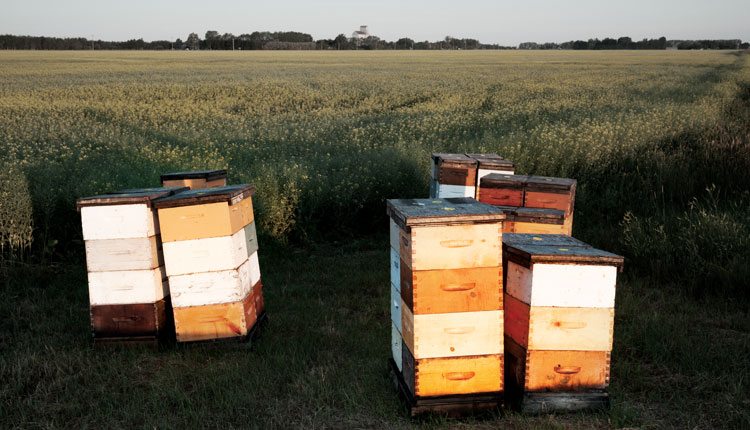What you as a seed treatment vendor need to know about the Ministry of Environment and Climate Change’s Regulation 63/09, which establishes a system for regulating a new class of pesticides.
_x000D_
As farmers begin to place their seed orders for the 2016 seeding season, the debate around pollinator health as it relates to the use of seed treatments, specifically neonicotinoid treated seed continues — both at the provincial and national levels. Ontario takes the spotlight when comes to this issue because of its newly approved regulations regarding the use of seed-applied neonicotinoids._x000D_
_x000D_
As part of its broader strategy to protect pollinators, the Ontario Ministry of Environment and Climate Change (OMECC) made changes to its regulations under the Ontario Pesticides Act to meet its goal of reaching an 80 per cent reduction in the number of acres planted with neonicotinoid-treated corn and soybean seed by 2017._x000D_
_x000D_
In doing so, the government of Ontario outlined that bee health has been declining — a cause for global concern — due to loss of habitat and poor nutrition, pesticide exposure, disease, pests and genetics, and climate change and weather._x000D_
_x000D_
These regulations “represent the least comprehensive plan on pollinator health available, disregarding the approach of the White House, the Senate and the Ontario Pollinator Health Blueprint — all holistic approaches,” said Mark Brock, Grain Farmers of Ontario chair, when the regulations came into law._x000D_
_x000D_
Known as Ontario Regulation 63/09, the amended regulation establishes a system for regulating neonicotinoid-treated corn and soybean seeds. First, it establishes a new class of pesticides, Class 12, under Ontario’s Pesticides Act and Ontario Regulation 63/09 for corn and soybean seed when treated with imidacloprid, thiamethoxam and clothianidin. Also, it establishes methods for farmers to assess if pest problems require the use of neonicotinoid-treated seeds. 63/09 sets out requirements for the sale and use of neonicotinoid-treated seeds and tracks the sale of neonicotinoid-treated seeds._x000D_
_x000D_
Vendor Requirements_x000D_
_x000D_
As part of the change, treated seed vendors who sell Class 12 pesticides must be licensed. The requirements vendors must meet include:_x000D_
_x000D_
• Obtain one license for each location._x000D_
_x000D_
• Name all treated-seed sales representatives._x000D_
_x000D_
• Submit a list of Class 12 pesticides that you intend to sell over a 12-month period, starting Aug. 31. This list is to be submitted by July 31 each year, starting in 2015; however, changes to the list can be made after this date._x000D_
_x000D_
• Offer untreated or fungicide only corn and soybean seed for sale._x000D_
_x000D_
Additionally, when advertising treated seed for sale, the vendor must make it known whether it’s Class 12 and whether it contains imidacloprid, thiamethoxam and clothianidin. The vendor must also advertise that corn and soybean seeds not treated with neonicotinoids are available for sale._x000D_
_x000D_
During the point of sale, vendors of Class 12 pesticides must collect certain information, which varies from 2015 to 2016 and 2017. This year, vendors must collect from the farmer a seed amount declaration form or a pest assessment report, showing inspection of the soil. This assessment can be completed by the farmer or any other person, according to OMECC._x000D_
_x000D_
In 2016, vendors must collect the Integrated Pest Management (IPM) Certification Number and have a written declaration that IPM principles have been considered, as well as a pest assessment report. The assessment report can be based off a soil inspection or crop inspection. Soil inspections can be completed by the farmer or any other person if completed before Aug. 31, 2016, or by an IPM certified person if completed on or after Aug. 31; whereas, the crop inspection must be completed by a professional pest advisor (PPA) only._x000D_
_x000D_
Then in 2017, vendors are required to collect the IPM Certification Number, a written declaration that IPM principles have been considered and the Pest Assessment Report. This report can be from a soil inspection or crop inspection. At this point, the soil inspection must be completed by an IPM certified person or PPA based on geographical region, and the crop inspection must be completed by a PPA._x000D_
“The amount of active ingredient introduced to the environment with seed treatments is only 10 per cent of that contributed by in-furrow treatments; and it’s only one per cent of foliar sprays.” — Dave Baute
_x000D_
After the point of sale, starting in 2016, Class 12 pesticide vendors must submit to Ontario’s Ministry of Agriculture, Food and Rural Affairs copies of each pest assessment report given to them during the previous 12-month period. These are due Oct. 31 of each year. For example, the 2016 submission will include reports from Aug. 31, 2015, to Aug. 30, 2016._x000D_
_x000D_
Additionally, vendors must complete a Sales and Transfer Report form and submit that to OMECC. This, too, is due Oct. 31 of each year starting in 2016. This form includes aggregating results of Class 12 pesticides and non-neonicotinoid treated corn and soybean seed sales. It also includes information from treated seed sales representatives, direct-to-farm vendors and the direct purchaser._x000D_
_x000D_
Treated seed vendors aren’t the only ones who have to meet these requirements. Treated seed sales representatives, direct-to-farm vendors and custom seed treaters also have responsibilities under 63/09; however, they do not have to be licensed._x000D_
_x000D_
New Data_x000D_
_x000D_
While government continues to push increased regulation, farmers and the seed industry don’t believe regulation is the best way to handle the pollinator health issue. They have introduced best management practises and put together their own blueprint for pollinator health leading up to the announcement._x000D_
_x000D_
And according to Scott Kirby, director of the Environmental Assessment Directorate of Health Canada’s Pest Management Regulatory Agency, the number and severity of incidents reported in association with neonicotinoid pesticide use during the 2014 seeding season was 70 per cent lower than the previous year. A full assessment of this year’s incidents is still underway._x000D_
_x000D_
Incidents relating to unproductive hives and poor performing queens later in the season have no clear link to neonicotinoid exposure, Kirby explains, noting that the science related to sub-lethal exposure to pesticides is not conclusive._x000D_
_x000D_
GFO’s Brock says, “Our organization firmly believes these regulations are not workable, and we are highly concerned about how they will negatively impact the future of grain farming in this province.”_x000D_
_x000D_
The Need_x000D_
_x000D_
In an opinion letter, Dave Baute, a farmer, president of Maizex Seeds and the 2014 Canadian Seed Trade Association president writes: “The amount of active ingredient introduced to the environment with seed treatments is only 10 per cent of that contributed by in-furrow treatments; and it’s only one per cent of foliar sprays.”_x000D_
_x000D_
Baute goes on to highlight that seed suppliers and farmers were the first to take decisive action when dust from planting seed was shown to have a negative impact on bees._x000D_
_x000D_
“In only a few months, we worked with regulatory bodies and seed treatment companies to develop best management practices designed to protect bee hives from planting dust,” he wrote. “We participated in countless farmer meetings, podcasts and retailer training sessions to ensure that the best management practises were implemented …_x000D_
_x000D_
“We updated and improved labelling on treated seed packaging material and put substantial financial and human resources into research projects to test equipment modifications to reduce dust. Seed suppliers offered farmers a greater choice of non-insecticide treated seed, and virtually all of the insecticide treated corn and soybeans in Ontario and Quebec were planted using a new lubricant that was shown to very substantially reduce dust while planting.”_x000D_
_x000D_
Baute explained that the results said it all, despite a very long, harsh winter._x000D_
_x000D_
Government Presses Forward_x000D_
_x000D_
Despite, hearing from farmers and the seed industry, Ontario’s government moved forward with its plans._x000D_
_x000D_
As such, GFO commenced legal proceedings against OMECC the week of June 22, asking the Superior Court to delay the implementation of the regulations until May 1, 2016, or “such time as the requirements of the regulation can reasonably be met.” If the court provided a stay against the regulations, farmers would be able to plant next year under the same rules followed in 2015._x000D_
_x000D_
On Sept. 28, Judge Sunhail Akhtar heard from representatives of GFO and the government of Ontario regarding the request for a stay of the seed treatment regulations brought into law July 1. After hearing testimony for four hours, the Akhtar reserved judgment on the case._x000D_
_x000D_
At the end of October, the judge ruled in favour of the government, writing: “Any claims of loss by farmers is purely speculative at this stage. By contrast, there is a public interest aspect to ensuring control of use of neonicotinoid-treated seeds to ensure that pollinators are not at risk.”











